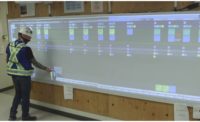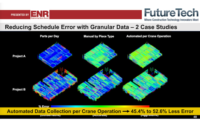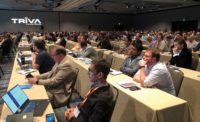“Ideas and solutions are the easy part,” says Ricardo Khan, senior director of innovation at Mortenson Construction. It’s “the process” that is the real challenge.
Khan’s midday keynote captured a key theme of the second day of the virtual ENR FutureTech conference—the need to identify the problems in your construction process before you start throwing technology at them. Speakers across the day went deep into the details of digital twin models and scanning jobsites with robotic dogs, but all of them touched on the basic rule that you have to know what it is you are after before deploying new technologies.
There are certainly problems ready to be solved in construction, according to Joshua Johnson, industry expert with McKinsey & Co.
“It turns out that technologies, among other things, are pretty significant levers to improve productivity in construction,” he told the assembled virtual audience. According to McKinsey’s own numbers, there is the potential for a 14% to 15% rise in productivity for construction firms by implementing more technology into its processes.
While there is a relatively low level of technology adoption, particularly among small and midsize construction firms, that creates opportunities for experimentation, says Johnson. “The level of digitization is low, but there is ton of white space out there for technology players to drive value in the construction industry.”
The potential for new technology to quickly take hold came up in a panel on “Digital Twin Models and AI for Owners of a Technology Campus Transformation.” Mani Golparvar, CTO of Reconstruct, and Shawn Mahoney, CEO and president of OAC Services presented about how going all in on a new approach can sometimes pay off.
Constantly Updating Model
Talking through the use of Reconstruct’s constantly updating model driven by reality capture, Mahoney says the extra effort spent on design can pay dividends during construction. “Our advice to clients is that putting everything into those models and the digital twin upfront, building it in the model first, verifies before you turn a shovel of dirt that you can build it in the field,” he says.
Reconstruct’s model of a project reflected every change on site, documented through drones and other visual captures. OAS has used it while serving as owner’s representative on a massive Microsoft campus in Redmond, Wash., with 18 buildings on 72 acres, and Mahoney says it was crucial to keeping the project on track. It all came from a chance encounter with a Reconstruct demo. “When I saw this at FutureTech two years ago, I almost jumped out of my seat,” he says.
Reality capture itself has come a long way in the last decade, and firms are finding the real business cases for deploying it. Panelists for “Turning Smart Imaging Into Smart Actions” discussed specific technologies they are testing on construction projects. Josh DeStefano, Southwest VDC leader with DPR Construction, said that the company has been using SmartTrack, a StructionSite tool that captures field data using 360° cameras and automatically updates quantities of work using AI on three projects. An inspector walks the site with the camera on a tripod or hardhat.
“When we have visuals and numbers, we can determine where we’re falling behind, and where are we being more productive,” he said. He noted that on average, 12 to 15 hours are spent a week on production tracking, not problem-solving, and not catching production issues early can result in up to 15% loss in profit.
DPR’s drywall team is using the automated video capture and machine learning to calculate and track work-complete against a 2D estimate with 99% accuracy with StructionSite. As DPR self-performs much of its work, including drywall and concrete, it plans to expand on the three pilot projects into “widespread utilization,” he said.
Eric Law, senior director of technology and innovation at Swinerton, discussed the company’s yearlong experience with Spot, the robotic “dog” from Boston Dynamics that walks a jobsite with 360° cameras and LIDAR scanning. The results were more consistent, higher-quality data than when humans had to do the weekly walk, he said. It turns out the robot was far steadier than a human using the same instruments, and better able to perform captures from a consistent height off the floor. Law’s team even used Spot to record air-quality levels on the site.
Law expects that within a year or two, the technology will become more cost-effective. “As the costs come down, [it will be] a viable solution,” he said.
Cultivating Innovation
And, as several presenters reiterated, real innovation is often more than just finding the right point solution. In his keynote, Ricardo Khan of Mortenson walked through his firm’s journey of cultivating innovation within the company. “We started with a centralized HQ model,” for innovation development, recalled Khan. But after a while the company realized that might be a bottleneck for new ideas. “We then moved into a distributed model, and allowed our businesses to take on those [new] processes, and we support them,” he explains. “It helped remove roadblocks [to adoption].”
And there was one last tip to deploying new innovations that Khan says is sometimes overlooked. “Don’t forget to talk to your legal and risk teams about IP [intellectual property] issues, it’s easy to forget that,” he says.











Post a comment to this article
Report Abusive Comment